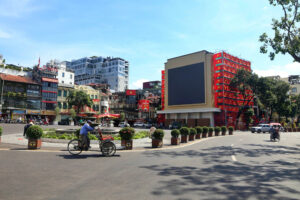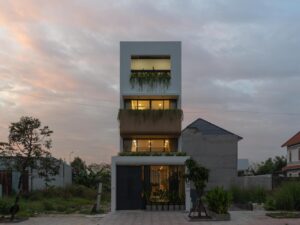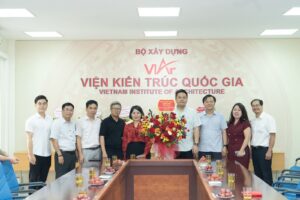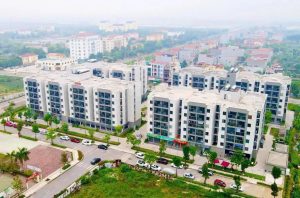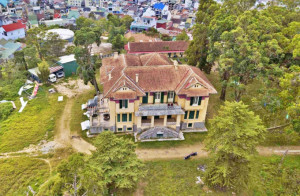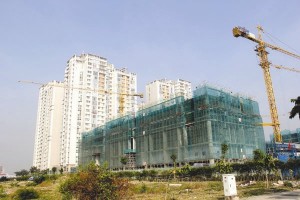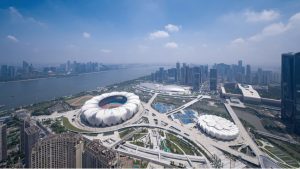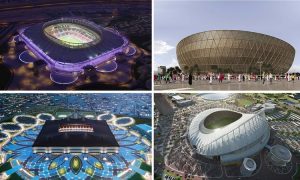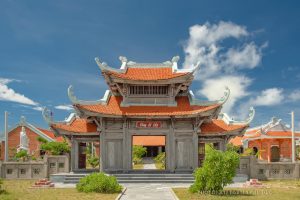Công bố quốc tế trong lĩnh vực kiến trúc, xây dựng (Tuần 1 tháng 8-2021)
Trong số này chúng tôi xin giới thiệu tới quý độc giả những nội dung chính của các công bố quốc tế đăng tải trên ScienceDirect và Springer Nature do Cục Thông tin khoa học và công nghệ quốc gia (NASATI) mua quyền truy cập như sau:
Quy hoạch đô thị:
– Ứng dụng chỉ số BIM (mô hình hoá thông tin xây dựng) cho hạ tầng đường bộ hiện có.
– Tìm hiểu những rủi ro về sức khoẻ có liên quan đến nhiệt độ trong bối cảnh quy hoạch sử dụng đất đô thị thay đổi.
– Phân tích chất lượng sinh thái cảnh quan ở Ngọc Lâm, Quảng Tây, Trung Quốc theo không gian và thời gian
– Chiến lược thích ứng hình học đô thị để cải thiện hiệu suất nhiệt ngoài trời ở các vùng khô hạn nóng: nghiên cứu điển hình ở Đại học Aswan, Ai Cập.
– Đánh giá việc so sánh thực hiện hoạt động bền vững xã hội: hệ thống trọng số theo hướng dữ liệu tích hợp và mô hình CoCoSo.
– Hướng tới các giải pháp tốt nhất sử dụng pin mặt trời quang điện cho các công trình nhà ở tại các khu đô thị.
– Hình thái đô thị ở Trung Quốc: sự phát triển tập dữ liệu và đặc điểm mô hình không gian.
– Cải thiện mức độ thoải mái tại các khu vực chờ giao thông ngoài trời bằng hệ thống phun sương: thử nghiệm và nghiên cứu bảng hỏi.
– Giải quyết tiềm năng cải thiện nguồn cung xây dựng đô thị: cách thức áp dụng cho trường hợp Tây Ban Nha.
– Nghiên cứu của CFD về đánh giá luồn gió phức tạp trong cấu trúc liên kết đô thị.
– Nền tảng tối tưu hoá xanh dựa trên trí thông minh Swarm cho hệ thống giao thông bền vững.
Khoa học và công nghệ trong lĩnh vực kiến trúc, xây dựng:
– Tổng quan về vật liệu thay đổi pha trong quang điện mặt trời ứng dụng trong các toà nhà.
– Thử nghiệm uốn dầm xây dựng có chứa xỉ từ lò điện hồ quang và các chất kết dính thay thế và kỹ thuật sản xuất tiết kiệm năng lượng.
– Các tác động của biến đổi khí hậu với việc thực hiện lập kế hoạch bảo trì và sử dụng các hệ thống kiểm tra toà nhà.
– Tối ưu hoá đa mục tiêu hiệu suất năng lượng cho một toàn nhà dân cư biệt lập có giếng trời bằng cách sử dụng thuật toán di truyền NSGA-II
– Hiệu quả của các mô hình dự đoán nấm mốc trong các toà nhà, từ góc nhìn của người dùng cuối.
– Thực hiện làm xanh các toà nhà đã sử dụng qua mô hình hoá thông tin toà nhà: đánh giá về sự phát triển gần đây.
– Lợi ích giảm thiểu nhiệt của cơ sở hạ tầng xanh đô thị: đánh giá có hệ thống các kỹ thuật mô hình hoá, xác nhận và mô phỏng kịch bản ENVI-met V4.
– Nghiên cứu các yếu tố ảnh hưởng đến hành vi mở cửa sổ của người dân: Nghiên cứu điển hình về một toàn nhà văn phòng ở Tây An, Trung Quốc trong thời điểm chuyển mùa.
– Phân loại bề mặt đô thị có độ phân giải không gian lớn bằng cách sử dụng phương pháp học sâu.
– Đánh giá hiệu suất địa chấn của kết cấu bê tông dạng đường hầm dưới các chuỗi động đất bằng cách phân tích thời gian chịu đựng.
Vật liệu xây dựng:
– Hiệu suất lâu dài của bê tông được bổ sung tro đốt bùn thải thành phố.
– Phát triển dầm liên hợp thép cán nguội bằng gỗ nhiều lớp cho hệ thống sàn để xây dựng toà nhà mô-đun bền vững.
– Đánh giá tác động của hiệu suất nhiệt đối với các loại gạch và khối xây dựng khác nhau.
– Hiệu suất nhiệt, năng lượng sử dụng và lượng khí thải trong các toà làm bằng rơm.
– Đánh giá việc sử dụng chất thải nhựa tổng hợp trong vật liệu xây dựng.
– Xác minh sự phát sinh các hạt vật chất do sự xuống cấp của vật liệu xây dựng là nguyên nhân gây ra bụi mịn trong nhà.
– Đánh giá độ dẻo của tường chịu cắt đúc sẵn RC trong các toà nhà hiện tại của Ý.
– Kho báu từ thùng rác: từ chất thải xây dựng đến vật liệu hấp thụ Tellurium.
– Ảnh hưởng của GGBS và điều kiện đóng rắn đến cường độ và tính chất vi cấu trúc của vữa xi măng giếng dầu.
– Đánh giá toàn diện tro sinh khối từ chất thải nông nghiệp làm vật liệu kết dính bổ sung hoặc thay thế vật liệu cốt trong bê tông.
Xin trân trọng giới thiệu!
QUY HOẠCH ĐÔ THỊ
- Building information Modelling (BIM) application for an existing road infrastructure
Automation in Construction, Volume 128, August 2021, 103752
Abstract
New technologies are changing the sector of infrastructures design and construction. One of the most important is the I-BIM (Infrastructure Building Information Modelling), that is a management information system of digital processes for infrastructures.
In this study the I-BIM approach has been used for the upgrade of a section of the SS 245 road, in the north of Italy, in order to show its benefits applied on existing road infrastructure.
The project involved the design of a new road segment and its connection with the existing road network and with a railway line. These last were respectively solved by a roundabout and by a jacked tunnel under the railroad with wing walls at each exit side of the structure.
The steps carried out in this study were modelling the 3D digital terrain model from point cloud; creating the horizontal alignment, vertical profiles and editing cross-sections; modelling the jacked tunnel; creating the roundabout; generating the 3D parametric model of the complete road and visualizing the infrastructure in the real-world context. The real innovation consists in the creation of a plugin that allows extrapolating directly from the design program to the compute one, all the features need to be calculated.
The BIM tools used were “Autodesk AutoCAD Civil 3D” and “Revit Structure”, used respectively for road geometrical design and for tunnel structural project.
The obtained results have been showed that the I-BIM approach represents not only a powerful tool to optimize and validate the road project according to norms before its construction, but also to see how the infrastructure works with the 3D real environmental context.
- Understanding temperature related health risk in context of urban land use changes
Landscape and Urban Planning, Volume 212, August 2021, 104107
Abstract
A city’s climate is affected both by global warming and the local factors such as built form and the landscape. The temperature related impacts of climate change make urban areas more vulnerable particularly due to higher population concentration as well as heat island effect. Cities in India are already experiencing enhanced temperature and precipitation related impacts of climate change and extreme events, e.g., >2 °C warming in some places. This study describes a case of Ahmedabad – a city of around 5 million people (Census, 2011) and currently almost 7.8 million, located in the hot and humid western part of India to understand the current temperature-related mortality impacts and the role of land use. Satellite images (MODIS from NASA), temperature data from India Meteorological Department (IMD) and daily all-cause mortality from Ahmedabad Municipal Corporation between 2001 and 2015 have been used to create a distributed lag non-linear model. Using land surface temperature for mortality risk assessment gives significantly different results as compared to using air temperature for mortality risk assessment. This indicates impacts of localized temperature variations on mortality risks. Thus, the microclimate in a city as represented by land surface temperatures is a better indicator for estimating relative risk of temperature related mortality as compared to air temperature. The study also infers that with increase in built-up spaces by 1% in the land use mix, the relative risk of heat related mortality increases by 0.59 points at 40 °C and by 0.78 points at 45 °C.
- Self-reported well-being and the importance of green spaces – A comparison of garden owners and non-garden owners in times of COVID-19
Landscape and Urban Planning, Volume 212, August 2021, 104108
Abstract
This study focuses on the effects of the use of green spaces on the self-reported well-being measures of life satisfaction and mental well-being during the COVID-19 pandemic. We compare two distinct groups of people: garden owners and non-garden owners. We collected quantitative data and data from an open-ended question online from 495 people living in all regions of Germany in May 2020. To analyze our quantitative data, we used a combination of descriptive statistics and hierarchal regressions. Here, results indicated that garden owners had substantially greater life satisfaction and mental well-being than non-garden owners. Additionally, the two groups differed statistically significant in many socioeconomic factors (e.g., income, age, fear of job loss), in the context of time spent outside, as well as personality traits. Our analyses suggest that these differences are valuable for understanding differences between the two groups’ self-reported well-being. To analyze the open-ended question, we followed the main steps of a qualitative content analysis. Here, we found that the vast majority of participants associated positive meanings (e.g., freedom and joy) with private gardens and public green spaces during the pandemic. Our findings have implications for policies to promote and support the design and use of public green spaces. Overall, our findings support governmental decisions in Germany (as elsewhere) to keep public green spaces open during the first wave of the outbreak of COVID-19, suggesting that green spaces provide valuable support for self-reported well-being in these difficult times of COVID-19 contagion.
- From landscape perspective to determine joint effect of land use, soil, and topography on seasonal stream water quality in subtropical agricultural catchments
Science of The Total Environment, Volume 783, 20 August 2021, 147047
Abstract
Understanding the relationship between integrated landscape patterns (coupled land use, soil properties, and topography) and stream water quality in different seasons promotes appropriate landscape planning. However, this relationship is unclear. Here, water quality nitrogen (N) and phosphorus (P) levels and the integrated landscape patterns were investigated in ten Chinese subtropical catchments during 2010–2017, using the least absolute shrinkage and selection operator (LASSO) regressions method and redundancy analysis (RDA). The results suggested that stream water N and P levels were significantly higher in the fallow season than in the rice-growing season (p < 0.05). The N and P levels in the rice-growing season were elevated with the increasing area proportions of tea fields in Ultisols on the medium slope (16.06–28.02°), and larger isolation, diversity, and geometric complexity of landscape patches, but decreased with the increasing area proportions of forests in Ultisols on the steep slope (28.02–80.30°) and interspersion of landscape patches. Stream water N and P levels were more likely influenced by landscape configuration in the rainy rice-growing season, mainly due to the rapid velocities and high quantities of surface flow strengthening landscape configuration effects on the N and P migration and exchange. In the fallow season, the N and P levels were heightened with the increasing area proportions of tea fields, residential areas, and paddy fields in Ultisols on the relative flat (0–16.06°) and medium slopes, and larger isolation of landscape, and could be greatly reduced if the area proportions of forests in Ultisols on the steep slope is increased. The N and P levels were more likely determined by landscape composition in the dry fallow season, associated with the slow and poor subsurface and underground hydrological flows. Therefore, the results promoted reasonable landscape management in different seasons and suitable soil and topography conditions for improving stream water quality.
- Spatial and temporal analysis of landscape ecological quality in Yulin
Environmental Technology & Innovation, Volume 23, August 2021, 101700
Abstract
Yulin is one of the important energy chemical industry area in China, located at the intersection of Loess Plateau and Mu Us Desert, and the vulnerability of ecosystem in this area is extremely prominent. Landscape ecological quality research helps to enhance ecological protection and high quality development in the region. The Remote sensing images in 2000, 2005, 2010, 2015 and 2018 of Yulin were interpreted to the landscape thematic data by ERDAS and ArcGIS10 and the landscape ecological quality model has been established in terms of the landscape ecological stability and disturbance. This paper aimed to reveal the spatial–temporal characteristics of landscape ecological quality. The results showed that: (1) the trend of landscape ecological quality firstly improve then degrade and enhance again during 2000–2018. (2) the landscape ecological quality improved and the areas with poor and fair landscape ecological quality reduced and the areas with high landscape ecological quality increased from 2000 to 2010. (3) the ecological quality was not optimistic during 2010 and 2015, with the areas with high landscape ecological quality reduced.(4) the ecological quality improved again from 2015 to 2018, and the areas with highest landscape ecological quality reaching 65.201% of total area. The changes of ecological quality were mainly driven by the project of returning farmland to forest, which increased vegetation coverage, reduced soil erosion, and achieved obvious results in ecological benefits, and these results may provide helpful information for the ecological conservation and development.
- Expanding the toolbox: Assessing methods for local outdoor recreation planning
Landscape and Urban Planning, Volume 212, August 2021, 104105
Abstract
Growing demand for outdoor recreation puts pressure on highly-frequented peri-urban areas. In the Netherlands, a more equal distribution of recreationists has been proposed by the Dutch government to relieve pressure on overcrowded recreation hotspots. Devising landscape planning strategies that redirect recreation flows requires reliable data on areas that people currently use and what areas would also be suitable for recreation. Such data may not be available for local planners. The objective of this study was therefore to analyse how different data gathering methods can support local recreation planning.
For an empirical case study in the Netherlands, we compare data on current and potential use of landscapes for outdoor recreation through participatory mapping, free listing, quantitative photo ranking, and analysis of social media data. Based on maps produced from these different data we interviewed local planners to assess how applicable and relevant the different methods are for planning practice. Local planners indicated they had limited knowledge of and access to scientific methods and insights. Their assessment of different methods suggests that some methods are not yet applied for local planning, such as free listing or participatory mapping. These methods have potential to be used for evidence-based planning, because they require few resources to be implemented. Planners also indicated that using social media data would be interesting, but that the skills required to collect and analyse data are typically not currently in place. Our results show the potential and challenges for research methods to be integrated into local planning practice to distribute recreation flows more effectively.
- Social innovation for a circular economy in social housing
Sustainable Cities and SocietyVolume 71, August 2021, 102925
Abstract
This study explored how social housing communities can contribute to the transition to a circular economy (CE) in cities. The CE promotes ways for rethinking and reshaping current practices of producing and consuming to enhance resource efficiency while satisfying our needs to enable us to prosper sustainably. Resource efficiency in cities relies on production and consumption patterns that are connected to people behaviours. Up to now, the CE has mainly concentrated on different levels of technological system innovations with limited attention to social practices and behavioural change. On the other side, communities and groups of interest show playing a crucial role in the promotion of sustainable practices through initiatives of social innovation (SI). Through case study analysis and comparison, the project investigated contemporary SI initiatives implemented by urban communities and groups of interest aiming at promoting alternative production-consumption practices. Seven types of SI for resource circularity have been identified. Based on this typology, the study defined potential opportunities, benefits and challenges for social housing communities. These findings also highlighted a complementary role that SI can play in the CE implementation in cities. Therefore, the project suggested the introduction of emerging SI concepts into the current CE approach to support development.
- Toward the construction of a circular economy eco-city: An emergy-based sustainability evaluation of Rizhao city in China
Sustainable Cities and Society, Volume 71, August 2021, 102956
Abstract
The construction of the circular economy eco-city (CEE) is the most effective way to solve the problem of sustainable urban development. To promote its development, the evaluation and tracking of its sustainability have become significant in academic exploration. However, few efforts have been made in this regard. Thus, this paper aims to fill this gap by choosing Rizhao city, a coastal CEE, as a case study and employing an emergy-based method to assess its sustainability from 2005 to 2017. The study results show that the socio-economic development depends on the utilization of local non-renewable resources. Moreover, the self-support ratio was found to be above 94 %, which, in turn, led to an increase in the environmental loading ratio. However, due to a rise in resource recycle ratio, the emergy sustainability index and sustainable development index first showed a decreasing trend and then an increasing one. Consequently, the performance of the circular economy has improved, especially in terms of resolving the dilemma between a superior environment and a backward economy. Nevertheless, the coordinated development within the system was not adequate. Therefore, further policy recommendations have been made to improve the overall sustainability of the circular economy in Rizhao city.
- Urban geometry as an adaptation strategy to improve the outdoor thermal performance in hot arid regions: Aswan University as a case study
Sustainable Cities and Society, Volume 71, August 2021, 102965
Abstract
Due to the lack of a comprehensive multiscale campus planning guideline, new universities in Upper Egypt are associated with a lack of environmental considerations of the surrounding climatic conditions. Additional extensions planned for the Aswan University campus located in New Aswan city provide an opportunity to explore thermal improvements in a hot arid environment. This study presents analytical and empirical findings that highlight the potential for their implementation in outdoor spaces. Most of the previous literature address the urban geometry from a single scale perspective. However, in this study coupled scales were adopted to get more effective thermal adaptation guidelines; urban form planning (cluster scale), and geometrical details (canyon scale). The study investigates five urban forms and 18 urban geometry scenarios to quantify their thermal impacts on outdoor spaces. All scenarios were evaluated according to the differences in geometrical variables, with data introduced based on on-site measurements and microclimate simulations using ENVI-met software. The results are ranked according to its influence on pedestrian thermal comfort. The suggested strategy could reduce the average PET value with 6.8 °C in the NS canyons and 4.2 °C in the EW during the peak hour. Design guides are introduced for planners and decision-makers.
- Comparative assessment of social sustainability performance: Integrated data-driven weighting system and CoCoSo model
Sustainable Cities and Society, Volume 71, August 2021, 102975
Abstract
Social sustainability is considered as the least defined and addressed pillar among the three pillars of sustainability. Social sustainability goals and targets within sustainable development goals are currently considered vital factors for human beings. Therefore, countries continuously evaluate their performance with respect to achieving social sustainability goals to promote required commitments and partnerships to address existing social problems and to maximize social satisfaction of their citizens. In this regard, this paper evaluates the social sustainability performance in seven developed countries that are included in the Group of Seven (G7) as one of the most important intergovernmental economic organizations. Assessing the performance of the countries is conducted based on real data from Organisation for Economic Co-operation and Development (OECD) dataset, where fourteen indicators are selected from different aspects that have noticeable roles on social sustainability. Evaluation of countries is done through a novel integrated data-driven weighting system based on CRITIC and Shannon’s Entropy methods, and CoCoSo method. Using the integrated data-driven weighting system, the weight of indicators is determined by using an aggregation operator to combine weights obtained from CRITIC and Shannon’s Entropy. The proposed integrated data-driven weighting system is designed to remove the biasedness and subjectivity of experts’ opinions that can happen using other weighting methods. Then, countries are comparatively evaluated and ranked using the CoCoSo. Based on the results of the proposed model, France shows the best performance with respect to social sustainability indicators.
- Performance of passive retrofit measures for historic buildings that house artefacts viable for future conditions
Sustainable Cities and Society, Volume 71, August 2021, 102982
Abstract
Retrofitting a building normally aims to achieve a higher quality indoor climate in terms of thermal comfort or in terms of air quality, as well as reducing the building’s energy consumption. Alternatively, in buildings that house artefacts, the application of retrofit measures normally aims to improve the indoor climate in terms of the artefacts’ conservation. However, the outdoor climate, which greatly influences the indoor climate of buildings, is changing significantly. Hence, it is obvious that when retrofitting a building it is of key importance to consider this change, especially in historic buildings that house high-valued artefacts.
This paper aims to study the performance of several types of retrofit measures in historic buildings that house artefacts by considering climate change. A validated hygrothermal model of a 13th-century church was used coupled with future weather files and a risk-assessment methodology based on damage functions.
It was found that passive retrofit measures can mitigate some of the negative impacts that climate change is expected to induce in historic buildings that house artefacts. However, these measures can also lead to the decrease of the conservation metrics. Consequently, ranges of thicknesses of the analysed retrofit measures that ensure the conservation metrics are presented.
- Towards achieving the best solution to utilize photovoltaic solar panels for residential buildings in urban areas
Sustainable Cities and Society, Volume 71, August 2021, 102968
Abstract
A way to find the best solution to utilize photovoltaic solar panels for residential buildings in urban areas is presented here. Three scenarios, namely, connecting to the grid with and without batteries, and full feed-in, are considered. After obtaining the optimal solution for each item, the best one is selected through a comprehensive comparison by considering energy, economic, and environmental criteria which are taken into account as the objective of the conducted multi-objective optimization. The combination of non-dominated sorting genetic algorithm II (NSGA-II) and technique for order preference by similarity to ideal solution (TOPSIS) is utilized for determination of the optimal answer for each scenario. A residential building complex in Tehran, Iran, as one of the biggest cities in the world is chosen as the case study. The results show that the full feed-in strategy offers the best condition among the alternatives. The optimal answer of this scenario enjoys the high performance ratio of 78.6 % (Performance ratio indicates the ratio of the actual to the theoretical energy output). Moreover, it provides levelized cost of electricity, payback period, and the internal rate of return of 0.15 $.(kWh)−1, 7.3 years, and 21.8 %, while it has the values of 487 $, 0.101 species.year, and 0.023 DALY for damage to resources, ecosystem, and human health, respectively.
- A review on the significance and perspective of the numerical simulations of outdoor thermal environment
Sustainable Cities and Society, Volume 71, August 2021, 102971
Abstract
Computer simulation programs have been used since 2006 for analyzing outdoor human thermal environments. This study reviewed 130 peer-reviewed papers published during 2006–2019, which investigated outdoor thermal comfort using computer simulations. Most studies were conducted in the Northern Hemisphere and the temperate oceanic climate during summer. The widely used computer simulation program and thermal indices were the ENVI-met and physiological equivalent temperature, respectively. To validate the simulation results for urban planning and design, 61 % of the studies compared the simulation results with observation data. Moreover, 45 % and 27 % of the studies validated the simulation results with measured air temperature and mean radiant temperature, respectively. Thermal indices were validated in 12 studies. Mitigation strategies to improve urban outdoor thermal environments can be analyzed in three categories: the effects of urban geometry, urban vegetation, and surface materials. To address the impact of climate change, future studies should consider the future urban structural plan and design scenarios, such as building heights, street orientations, and surface types. Moreover, further studies can adopt multi-scale approaches (e.g. global scale, mesoscale, and micro-scale). This study will help researchers select a suitable numerical simulation program according to their requirements.
- Urban morphology in China: Dataset development and spatial pattern characterization
Sustainable Cities and Society, Volume 71, August 2021, 102981
Abstract
Characterizing urban morphology is critical for urban climate examination and modeling. However, high-resolution urban morphological datasets are lacking, especially in Chinese cities that undergoing fast-urbanization. We proposed a two-step rasterization method to develop an urban morphological dataset at a resolution of 100 m for 36 major cities in China. The morphological dataset includes building height, width, fraction, and street width as well as sky view factor and frontal area index. We then characterized the spatial patterns of these morphological parameters within and across cities. In general, the derived morphological parameters match the raw vector data well in terms of both magnitude and spatial distribution at the block, district, and city scales. The morphological parameters show large spatial variations within and across cities. On the city scale, the city center shows a larger building height and frontal area index, but smaller street width and sky view factor, compared to the city edge. Across cities, the morphological parameters generally show latitudinal variations, with higher building height and frontal area index, but smaller street width and sky view factor in the south. This new morphological dataset provides fundamental data to examine urban climate mechanism, classify urban land use, and drive urban climate model.
- Outdoor comfort level improvement in the traffic waiting areas by using a mist spray system: An experiment and questionnaire study
Sustainable Cities and Society, Volume 71, August 2021, 102973
Abstract
Outdoor hot environment in summer affects human health seriously, and it is very difficult to be improved by air-conditioning equipment. However, some outdoor activities are unavoidable and taking the public transportation is the main way, especially for medium and low-income population, so improving thermal environment in urban transportation waiting areas is necessary and significant. Based on this, the mist spray system was considered to improve the human thermal comfort in the urban transportation waiting areas. A bus station model was established to analyze the influence of the mist spray system through experimental test and questionnaire. The results showed air temperature was reduced obviously, while thermal comfort was well improved in the mist spray system. The average air temperatures were decreased by 2.6 °C, 2.1 °C and 3.3 °C in the head, the nasal cavity, and the chest, respectively. Human thermal sensation was increased from 1.44 (between slightly hot and hot) to 0.33 (slightly higher than neutrality), while thermal comfort was improved from −1.13 (slightly uncomfortable) to 0.76 (slightly comfortable). And female and obese participants had more sensitivity on thermal sensation and comfort level. And the mist spray system could be used widely in practice due to its wide acceptability of 76 %.
- Addressing the potential for improvement of urban building stock: A protocol applied to a Mediterranean Spanish case
Sustainable Cities and Society, Volume 71, August 2021, 102967
Abstract
Current plans to combat the environmental global impact of the building sector have encouraged research on sustainable actions for increasing the renovation rate of many buildings whose performance is far from meeting current energy standards.
This paper presents a protocol for analysing the existing residential stock towards planning building upgrading actions. A Geographic Information System with building-related data is used to assess the housing stock following a bottom-up approach. The urban study sample is established using several criteria at building level. The potential for improvement of buildings is ascertained using DOE 2.2 energy models which incorporate standard passive strategies to reduce the current primary energy demand and the associated CO2 emissions.
The protocol is applied to the existing public housing developments built in the southern Spanish city of Córdoba, under Mediterranean conditions, during the urban expansion period which spanned 1951–1980.
The extrapolation of results to the urban study sample shows a 25 % reduction in CO2 emissions and a 40 % decrease in annual energy demand. Furthermore, the impact of typology and position on the energy behaviour of a given building is acknowledged.
The benefits achieved aim to help stakeholders in the implementation of energy retrofitting urban plans.
- Evaluation of coupling coordination degree and convergence behaviour of local development: A spatiotemporal analysis of all Polish municipalities over the period 2003–2019
Sustainable Cities and Society, Volume 71, August 2021, 102992
Abstract
This paper examines local development processes in the Polish municipalities between 2003 and 2019. In order to take into account the concept of sustainability, local development is represented by six dimensions: economy, demography, housing, society, infrastructure, and environment. First, using an index system and entropy weight method, the local development index (LDI) is calculated. Second, a coupling coordination degree (CCD) model is applied to study whether the processes of local development dimensions change in harmony. Thirdly, employing a convergence analysis, the studied municipalities are grouped into homogeneous clusters regarding LDI and CCD. Finally, the quadrant method and the ordered logit model are used to indicate directions for improvement in LDI and CCD. The research indicates that Polish local governments exhibit significant disparities in terms of LDI, whereby infrastructure and environment dimensions are the main obstacles to growth for the surveyed municipalities. Moreover, the CCD model shows that the vast majority of Polish municipalities are characterised by seriously or slightly unbalanced development, which also implies the conclusion that development processes in Polish municipalities cannot be called sustainable. Furthermore, club convergence analysis estimates inform that there are seven clubs in Poland in terms of LDI and five clubs in CCD. In addition, quadrant analysis reveals that, in general, urban municipalities belong simultaneously to the convergence clubs with high LDI and CCD. On the other hand, rural municipalities tend to be present in clubs with low LDI; therefore, they should take urgent pro-development measures. The latter is indicated through the identified main obstacles to local development as well as in the final stage of the empirical study through the estimation of ordered logit models.
- A CFD study of wind assessment in urban topology with complex wind flow
Sustainable Cities and Society, Volume 71, August 2021, 103006
Abstract
This paper presents a CFD study on the air ventilation assessment (AVA) in urban topology with twisted wind profiles (TWP). At present, most AVAs were conducted through wind tunnel experiments, and conventional wind profile (CWP) with no deviation of wind direction along the heights was employed. However, in practice, the hilly terrain around cities such as Hong Kong results in twisted wind flow that wind directions vary along the heights. This paper presents an LES-based CFD model based on the best practice guidelines (BPGs). Two twisted wind profiles (TWP) were introduced, and six simulation cases were performed. The CFD predicted wind speeds were validated against wind tunnel measurements in the literature, and good agreement was achieved. With the aid of the CFD model, wind conditions over heights were investigated, and the effects of twisted wind were evaluated. The results indicated a significant influence of TWPs on the AVA’s outcomes and the wind speeds’ vertical distribution. In addition, with the CFD results, it is possible to investigate the wind-structure interactions in specific urban areas and provide a better understanding of the effects of buildings on the local wind conditions, which could be useful to the urban plan for sustainable cities.
- Swarm intelligence-based green optimization framework for sustainable transportation
Sustainable Cities and Society, Volume 71, August 2021, 102947
Abstract
Traffic congestion is one of the most critical issues in developing sustainable transportation in smart cities. As the Internet of Things evolves, connected vehicle technology has arisen as an essential research topic in smart, sustainable transportation. This study investigates a decentralized green traffic optimization framework by pushing swarm intelligence into connected vehicles to mitigate traffic congestion. We present a dynamic traffic routing method based on ant species’ swarm intelligence for connected vehicles so that they can communicate with each other and their surrounding environment via digital pheromones to perform routing decision-making in a decentralized manner. Traditional pheromones attract other vehicles to move to the optimal path, which will soon be congested if many vehicles travel on that path concurrently. To overcome this limitation, we propose the concept of repelling pheromone, which generates a repulsive force among vehicles so that their travel paths are distributed throughout a road network, resulting in a congestion-free road network. The proposed method is validated in the Simulation of Urban Mobility platform. Simulation findings reveal that the proposed method outperforms baseline methods in mitigating traffic congestion, reducing average fuel consumption and emissions by 13–19% and the average trip duration by 19–28%.
- How to bring UHI to the urban planning table? A data-driven modeling approach
Sustainable Cities and Society, Volume 71, August 2021, 102948
Abstract
While temperature rises in urbanized area there is a growing concern among key decision-makers and urban planners to actively incorporate Urban Heat Island (UHI)-related considerations in their development/design. However, given that the existing models (mainly physics-based) are too complex to use, there is a need for an easy-to-use decision support tool that provides an explicit understanding of the contributions of different urban planning decision-making parameters on UHI. To this end, this research uses publicly available data to develop a data-driven methodology that mines explicit rules about the correlation between socio-economic and urban morphology features and UHI at a street-level. By implementing a tree-regression approach, five distinct categories of potential UHI were identified. These categories represent five levels of UHI, from low to high, where explicit thresholds are identified for each feature. The optimal model based on accuracy and interpretability is a decision tree (DT), with an accuracy of 93 %. With the results of the case study, it is demonstrated that (1) the proposed methodology leads to an easy-to-use tool that can be implemented by urban planners to investigate the impact of their design choices at the street-level, and (2) the results obtained are consistent with the current body of knowledge, which in turn alleviates the drawbacks of traditional methods.
- The influence of urban form on surface urban heat island and its planning implications: Evidence from 1288 urban clusters in China
Sustainable Cities and Society, Volume 71, August 2021, 102987
Abstract
There is a growing demand for urban form optimization to mitigate urban heat island (UHI) effect. Nevertheless, how UHI responds to various urban morphological patterns is still limitedly understood, especially for cities in developing countries. Here, based on 1288 urban clusters identified automatically across China, we created a consistent analytical environment to recognize both homogeneity and heterogeneity of the relationship. Specifically, urban form was characterized from aspects of size, shape, and centrality, respectively measured using metrics of urban size, area-weighted mean shape index (AWMSI) and dispersion index (DI), entropy and Moran’s I. Then, relationships between the metrics and surface UHI (SUHI) were modelled using the ordinary least squares (OLS). Results reveal that in nighttime when stronger relationships were observed than in daytime, centrality, a feature of intra-urban development structure largely neglected by previous studies, dominated as the most influential aspect. The relationships also varied across climate zones. A two-step OLS regression further reveals them to be size-dependent. As city expanded, the rising shape irregularity created a cooling impact, while the rising centrality leaded to urban warming. Overall, this study suggests that, in addition to controlling urban expansion, the optimal urban form for SUHI mitigation is moderately dispersed, polycentric, and decentralized.
KHOA HỌC VÀ CÔNG NGHỆ TRONG LĨNH VỰC KIẾN TRÚC, XÂY DỰNG
- Phase change materials in solar photovoltaics applied in buildings: An overview
Solar Energy, Volume 224, August 2021, Pages 569-592
Abstract
Building sector is responsible for approximately 40% of global carbon dioxide emission. Accordingly, any measures for reducing building energy consumption or providing it with renewable sources would substantially benefit sustainable development. A major approach towards this goal could be the application of photovoltaic modules in buildings, which could be conducted in various configurations. Integrating phase change materials with photovoltaic panels could simultaneously provide thermal regulation for the panel as well as thermal energy storage for the building. During the last two decades, research efforts on photovoltaic-phase change material systems for building applications have considerably grown. A systematic review of the current state of knowledge on photovoltaic-PCM modules applied in buildings could greatly benefit future research in this area. With this purpose in mind, the present study reviews the building applications of photovoltaic-phase change material units. The study aims to classify the existing literature on the field for acquiring a better understanding of the technological progress as well as identifying the existing gaps and future research prospects. Research attempts are categorized in four experimental, numerical, optimization, and economic sections. Each category is thoroughly analyzed and discussed in terms of current state of knowledge. Finally, technical analysis and possible future subjects are introduced and discussed.
- Bending tests on building beams containing electric arc furnace slag and alternative binders and manufactured with energy-saving placement techniques
Structures, Volume 32, August 2021, Pages 1921-1933
Abstract
The environmental impact of the building sector is especially relevant during the construction phase. Both the materials and the construction methods that are currently in use must be reconsidered, in order to minimize the environmental impact of concrete-based structures. This research is therefore focused on achieving greener concrete-based building structures. In this context, the feasibility of careful use of materials for concrete manufacture and the use of construction techniques that can facilitate and reduce energy consumption during placement are both studied. To do so, twelve sample beams were prepared using eight different sustainable high-workability structural concretes. The aim was to maximize the use of the by-products that amounted to over 80% of the concrete mass, steelmaking slags, fly ash, and quarry waste, and to employ energy-saving concrete placement techniques. The beams underwent bending tests in which their mechanical behavior and their compliance with the specifications of the most relevant building codes were verified. The results pointed to the feasibility of increased sustainability in the field of building engineering through the suitable use of selected by-products and techniques.
- 3. Inner wall filler as a singular and significant source of indoor radon pollution in heritage buildings: An exhalation method-based approach
Building and Environment, Volume 201, 15 August 2021, 108005
Abstract
The presence of radon in buildings is a matter of growing concern in the industry. A further layer of complexity is present in heritage buildings, where sources of exhalation other than those observed in more modern conventional buildings may render diagnosis and intervention even more difficult. This study explored the high exhalation rates originating in the inner fillers in thick elements such as bearing walls and structural floors and vaults characterising historic construction. They were found to be close to the values observed in soils and one to two orders of magnitude greater (range: 32.5 mBq/m2·s to 149.7 mBq/m2·s) than found in the construction materials themselves, such as granite. The radon emitted into building interiors by those members exhibited more or less uniform concentration profiles on all storeys, irrespective of elevation and consequently distance form the soil. Further to the results delivered by an accumulative model, the only explanation for the empirical findings is that the inner filler in structural members sources a substantial fraction of the high exhalation rates. That would open a new exploratory pathway for remedies that should necessarily address all emissions, rather than deeming the soil as the sole or primary source of radon gas. The issue is broached in this article on the grounds of a case study of the Tower of Hercules at Corunna, Spain, a building dating from Roman times and presently used as a museum and monument open to the public.
- Seismic fragility models for typical non-engineered URM residential buildings in Malawi
Structures, Volume 32, August 2021, Pages 2266-2278
Abstract
Malawi is an earthquake-prone country that lies within the East African Rift. A large proportion of its population lives in non-engineered single-storey constructions made of clay bricks and low-strength mortar. Walls are typically single-skin and often lack adequate wall-to-wall connections, leaving them vulnerable to seismic actions. This work reports a comprehensive study on the seismic fragility of unreinforced masonry buildings of the Malawi housing stock. The probability of exceeding different levels of in-plane/out-of-plane damage is estimated by considering the aleatory and epistemic uncertainties of the problem. Inter-building and intra-building variability are accounted for by adopting material test results and building survey data collected in Malawi. The in-plane capacity of building walls is calculated through a finite element model that considers the orthotropic properties of masonry. The out-of-plane capacity is computed using an analytical solution, developed for walls in one way bending. In addition, record-to-record variability is considered. The new country-specific fragility models result more conservative that global estimates, which reflects the high vulnerability of Malawian masonry buildings. These fragilities can be integrated into catastrophe modelling platforms for earthquake risk assessment in Malawi and in the wider East African region.
- Hallway exploration-inspired guidance: applications in autonomous material transportation in construction sites
Automation in Construction, Volume 128, August 2021, 103758
Abstract
Continued attempts have been conducted to improve construction productivity with automatic material transportation robots, yet neither of them has been popularized. The reason is that navigating in highly unstructured and dynamic indoor environments remains a great challenge. Therefore, we present a hallway exploration-inspired guidance approach (HEIGA), which guides an agent to its destination based on a series of directional guidance without the need for self-localization in a global frame. A series of experiments were conducted which prove that fully autonomous material transportation can be realized without being influenced by the complexity or dynamics of real construction sites. We expect this new approach to effectively: (i)free workers from heavy and repetitive material transportation tasks; and (ii) improve construction productivity. In the future, the presented approach will be applied in construction sites considering multi-robot collaboration, aiming at a higher material transportation efficiency.
- Implications of climate change in the implementation of maintenance planning and use of building inspection systems
Journal of Building Engineering, Volume 40, August 2021, 102777
Abstract
Alterations in climate parameters and severe weather events, within the context of anthropogenic climate change, will likely lead to soil instability and harsher exposure conditions of the building’s enclosures, having direct implications on the acceleration of degradation phenomenon. Maintenance planning needs to be improved, to minimise predicted effects of climate-induced risks on a vulnerable built environment, contributing to the sustainability and resilience of constructions. The purpose of this research is to make a literature review on the topic of climate change adaptation and building maintenance and use it as the base to point out possible further developments regarding maintenance planning contribution to the adaptation of building stock management. The implementation of maintenance activities with this aim is still incipient and based on theoretical approaches. Despite the scarcity of research on this topic, the literature covers several relevant complementary tools to maintenance planning, also included in the present paper, considering their essential role to the efficient implementation of climate change adapted maintenance. Future works lay on: (i) the development of tools that connect climate agents to buildings degradation, (ii) their integrated contribution to maintenance planning and (iii) the optimized use of inspection systems.
- Multi-objective optimization of energy performance for a detached residential building with a sunspace using the NSGA-II genetic algorithm
Solar Energy, Volume 224, August 2021, Pages 1426-1444
Abstract
This paper discusses a performed optimization of the structural and architectural parameters of a detached passive building with a sunspace using a non-dominant sorting genetic algorithm (NSGA-II). The building optimization is performed on the model of a building located in Niš, Serbia, a city with a Cfa climate according to the Köppen classification. The optimization is based on the NSGA-II algorithm and was run using DesignBuilder software package coupled to EnergyPlus™ dynamic building energy simulation software. The defined variable optimization parameters (X1-X10) include parameters of passive solar design, such as window-to-wall ratio (WWR) of each individual building façade, type of glazing, different façade wall constructions, and window shading system on the façades. Prior to the optimization itself, a sensitivity analysis of parameters X1-X10 was conducted in order to identify the parameter that has the most influence on heating and cooling energy expenditure and on thermal comfort. The Latin hypercube sampling (LHS) method is used to create iterations. Optimization objectives are defined for two scenarios. Scenario 1 considers the minimum energy required for heating and the minimum energy required for cooling of a detached passive residential building with a sunspace, while Scenario 2 considers the minimum energy required for heating and the minimum number of discomfort hours in such a building. The results of the optimization are obtained through NSGA-II iterations according to the predefined optimization objectives and by varying the given structural and architectural parameters of the building. The results are presented as a Pareto front – a set of optimal solutions and optimal characteristics of the detached passive solar building. For Scenario 1, the optimization yielded 63 Pareto solutions after 4245 iterations. For Scenario 2, it yielded 25 Pareto solutions after 4393 iterations. Based on the hypervolume indicator (HV), it can be concluded that multi-objective optimization using NSGA-II for Scenario 1 (HV1 = 0.82164) performed better than for Scenario 2 (HV2 = 0.59855). Optimization results show that when designing a detached passive solar building with a sunspace for the Cfa climatic area according to Köppen, window-to-wall ratio is the element of passive solar design that influences energy performance the most. In addition, a detached passive solar building will benefit the most from triple low-emissivity argon-filled glazing, opaque elements of the building envelope need to be properly thermally insulated with thicker concrete or brick walls for higher thermal storage capacity, and no shading or the smallest possible awning size is recommended for the south-facing façade to achieve better solar gains.
- How well do mould models predict mould growth in buildings, considering the end-user perspective?
Journal of Building Engineering, Volume 40, August 2021, 102301
Abstract
Mould growth results from a complex interaction between environmental factors, material properties, and mould fungi characteristics. These interactions must be considered during the design, construction and maintenance of a building to prevent growth. Mould prediction models aim to predict whether mould will grow on a specific material in a part of building with a known, or simulated, relative humidity and temperature. They are often used in the design phase. Several models are available. There is limited research on the performance of the models in real buildings. This study aimed to evaluate six different models, using data from five building parts. The predictions on whether mould growth was expected or not were compared to actual mould growth observations on five building materials. The study was performed as a round-robin. Most models underestimated the possibility for mould when humidity and temperature varied a lot by time. The outcome also depended on the end-user, who needs to make assumptions and parameter values choices on, for example, material susceptibility for mould growth. Therefore, using the same climate data, mould growth prediction may differ depending on who makes the prediction. One model, MOGLI model, where input data comes from laboratory tests and no such assumptions must be made, predicted correct in most cases. One conclusion of the study is that when predictions are made in practice, the results must be used cautiously. More knowledge is needed to understand, and more accurately model, the relationships between the moisture and temperature variations in buildings and the risk for mould growth.
- Greening existing buildings through Building Information Modelling: A review of the recent development
Building and Environment, Volume 200, August 2021, 107924
Abstract
The use of Building Information Modelling (BIM) for green retrofitting is a recent development due to its integrated solutions for evaluating and monitoring the environmental sustainability performance of existing buildings. It can be implemented throughout different stages of building life cycle using centralized digital models. However, the actual applications of such technology are still scarce and require further study and verification. In this paper, a systematic review of the recent development of BIM was conducted on two related areas: (a) existing buildings’ sustainability performance and (b) green retrofitting. The review highlights that little work has been conducted on these two areas concurrently which is mainly at the exploration stage. The results further reveal common BIM sustainability tools, performance parameters and design parameters in the recent research on the green retrofitting of existing buildings. Furthermore, a research framework has been developed to fill the research gaps and future needs in the implementation of BIM for green retrofitting, including data acquisition techniques, integrated process, unified platform, data interoperability and management, level of automation, design alteration as well as auto data feedback. This paper provides new insights into both theoretical developments and practical or technical aspects of BIM in fostering a complete green retrofit ecosystem.
- Heat mitigation benefits of urban green and blue infrastructures: A systematic review of modeling techniques, validation and scenario simulation in ENVI-met V4
Building and Environment, Volume 200, August 2021, 107939
Abstract
Urban green and blue infrastructures (GBI) are considered an effective tool for mitigating urban heat stress and improving human thermal comfort. Many studies have investigated the thermal effects of main GBI types, including trees, green roofs, vertical greenings, and water bodies. Their physical characteristics, planting designs, and the surrounding urban-fabric traits may impact the resultant thermal effects. ENVI-met, a holistic three-dimensional modeling software which can simulate the outdoor microclimate in high resolution, has become a principal GBI research tool. Using this tool, the GBI studies follow a three-step research workflow, i.e., modeling, validation, and scenario simulation. For providing a systematic and synoptic evaluation of the extant research workflow, a comprehensive review was conducted on GBI-targeted studies enlisting ENVI-met as the primary tool. The findings of 79 peer-reviewed studies were analyzed and synthesised for their modeling, validation, and scenario simulation process. Special attention was paid to scrutinising their data sources, evaluating indicator selection, examining main analytical approaches, and distilling recommendations to improve the research workflow. This review provides researchers with an overview of the ENVI-met methodology and recommendations to refine research on GBI thermal effects.
- Study on influencing factors for occupant window-opening behavior: Case study of an office building in Xi’an during the transition season
Building and Environment, Volume 200, August 2021, 107977
Abstract
Window-opening behavior profoundly affects indoor air quality, thermal comfort, and the energy consumption of HVAC systems in office buildings. This paper presents the results of a field study on manual window control conducted in five typical individual offices in the building of a research institute in the city of Xi’an, located in the cold region of China. The average duration of window-open and window-closed states was 5.3 h/day and 6.7 h/day during working hours, respectively, and thus the window-open state accounted for 44% of the total duration during the transition season. Unlike previous studies, the results show that once a window was opened when occupants first come to the office, it would not be left like that for long, until the occupants left the office at the end of day. In addition, window opening behavior is more strongly correlated with indoor PM2.5 concentration and indoor temperature. A new algorithm has been developed that applies dummy variables based on a binary logistic to provide a more accurate description of the relationship between the window state and influencing factors at different levels. The proposed model increased the prediction accuracy of the window being open by 5.9% compared to the continuous variable model. This study focuses on understanding the characteristics of window operation and establishing a more accurate model that offers suitable data and theoretical support for applications to simulate energy consumption in office building.
- High spatial-resolution classification of urban surfaces using a deep learning method
Building and Environment, Volume 200, August 2021, 107949
Abstract
Urban surface composition is key information for global carbon emission estimation, mesoscale numerical simulations, and outdoor environment studies at both city and neighborhood scales. High spatial-resolution satellite imagery can provide accurate urban surface data. Due to the large volume of data, it is time-consuming to extract manually information from satellite imagery or use other conventional classification methods. Deep leaning-based classification methods have great potential in satellite imaginary recognition due to their high efficiency and accuracy. In this study, we established a novel workflow for deep learning-based satellite imagery classification. At the stage of training dataset preparation, an object-based image analysis (OBIA) classification with the assistance of open source ancillary data from OpenStreetMap (OSM), i.e., OBIA-OSM method, was proposed to accelerate the procedure and improve the accuracy. An area of 33.5 km2 training dataset with 1 m spatial resolution was built based on the Gaofen2 satellite imagery of Hangzhou, China (GF2-HZ dataset). A Res-UNet + inception model was developed for the deep learning process. The results using the newly built model were compared with those from previous FCN and UNet models. The overall accuracy of our proposed model on the GF2-HZ dataset reached 83.1% which outperforms previous models. The influences of raw data-related factors, such as spectral bands composition and spatial resolution, were carefully tested. Data normalization and ‘transfer learning’ techniques were also analyzed and applied to improve the generalization ability of deep learning models.
- Seismic performance assessment of tunnel form concrete structures under earthquake sequences using endurance time analysis
Journal of Building Engineering, Volume 40, August 2021, 102327
Abstract
A low-computational cost method is developed for seismic performance assessment of tunnel-form concrete structures under earthquake sequences. Using incremental dynamic analysis (IDA), a structure already damaged under a code spectrum-compatible mainshock is subjected to a set of aftershock events. The seismic reliability of the structure under successive earthquakes is then evaluated by comparing the fragility curves of the intact and the damaged structures. To achieve this, the newly developed endurance time approach is used to obtain the residual capacity of the structures to withstand aftershocks. The efficiency of the proposed method is demonstrated by using 5 and 10-storey 3D tunnel-form concrete structures as case study examples. It is shown that using endurance time method for seismic performance evaluation under mainshock-aftershock sequences generally leads to accurate results (less than 15% error), while it can significantly reduce (up to 90%) the computational costs of the conventional IDA method. The results also indicate that the application of the code design basis earthquake as the mainshock has no significant effect on the seismic performance of the tunnel form concrete structures under aftershocks, especially for the shorter systems. This highlights the excellent seismic resistance of tunnel-form structures under earthquake sequences
- Experimental and numerical highlighting of water vapor sorption hysteresis in the coupled heat and moisture transfers
Journal of Building Engineering, Volume 40, August 2021, 102321
Abstract
Heat, air and moisture transfers have a significant influence on indoor ambience and affect both temperature and hygrometry values and energy performance of buildings. Furthermore, high levels of humidity may lead to severe pathologies in building walls in addition to tamper indoor air quality and hygrothermal comfort. Sorption hysteresis phenomenon is responsible for the moisture accumulation in porous building materials, and leaving it out in hygrothermal modelling would result in an incorrect water content value.
The present work aims to highlight the influence of the sorption hysteresis phenomenon on heat and moisture transfer in expanded polystyrene concrete. In order to achieve this, a coupled heat and mass transfer model will be elaborated, taking consideration of sorption hysteresis phenomenon. Experimental protocols will be conducted to highlight the hysteresis in the materials, and the results will be compared to those of the numerical simulations. A simple hygrothermal transfer model without including hysteresis will also be used in the numerical simulations so that it is compared to the developed model. Experimental results show that considering the hysteresis phenomenon allows to better apprehend the hygrothermal behavior of building materials, and neglecting it leads to important differences sometimes reaching 28%.
- CFD analysis of the impact of geometrical characteristics of building balconies on near-façade wind flow and surface pressure
Building and Environment, Volume 200, August 2021, 107904
Abstract
The presence of building balconies can significantly modify the near-façade wind flow pattern and surface pressures. The present study evaluates the impact of building balcony geometry on mean wind speed on balcony spaces and wind-induced mean surface pressure for generic high-rise buildings. The focus is on balconies that extend along the entire width of the building façade. Large-eddy simulations (LES), validated with wind tunnel experiments, are conducted to investigate the impact of (i) balconies present or not, (ii) balcony depth, (iii) balcony parapet walls, (iv) balcony partition walls, and (v) density of balconies. The results indicate that the balcony geometry can greatly affect the mean wind speed on balcony spaces and the local and façade-averaged mean pressure coefficient (Cp). The presence of balconies can increase the façade-averaged Cp over the windward and leeward façades by 5.2% and 8.9%, respectively. These numbers rise to 23.5% and 23.3% when two partition walls are added at the lateral edges of the façades. Adding five partition walls can reduce the overall area-averaged wind speed on balcony spaces by 68.0% compared to the case without partition walls. These findings can be useful in developing, designing and constructing buildings with façade geometrical details that improve building ventilation, air quality and wind comfort.
- Thermal and noise insulation performance interaction of building envelope during building simulation optimization in tropical climates
Building and Environment, Volume 200, August 2021, 107948
Abstract
Building simulation optimization is being increasingly adopted by researchers and designers as an efficient methodology for early-stage design and selection of building envelope parameters. Thermal performance has been the focus of many of the proposed methodologies owing to large energy consumption in buildings to maintain thermal comfort for the occupants. While the envelope is optimized to enhance its thermal performance, the effect on its noise insulation performance is not paid any attention as both performance objectives are assumed to be non-interacting or non-conflicting. It may be possible that the optimization for thermal performance may lead to degradation in noise insulation performance or vice versa. The present work aims to study the interaction between the thermal and noise insulation performance of the building envelope during a building simulation optimization process when both the performance objectives are optimized independently and simultaneously. The results obtained show the adverse effect of independent thermal and noise insulation optimization on noise insulation and thermal performance of the building envelope walls respectively. An exception was observed in the case of independent noise insulation optimization of both 8-hour and 24-hour conditioned buildings where average thermal performance of the final population was enhanced along with the noise insulation performance.
- Integrated impacts of building height and upstream building on pedestrian comfort around ideal lift-up buildings in a weak wind environment
Building and Environment, Volume 200, August 2021, 107963
Abstract
Unfavorable wind comfort and intense thermal discomfort are degrading pedestrian comfort in high-density cities. The lift-up design has proved to be a promising way to improve wind comfort and thermal comfort around buildings. Previous studies have identified building height as a crucial factor influencing wind comfort around lift-up buildings. However, the correlation between building height and wind comfort has not been fully understood yet and few parametric studies have been focused on thermal comfort. This study thereby aims to evaluate the integrated effects of building height and upstream building on pedestrian comfort around lift-up buildings from aspects of wind comfort and thermal comfort. Computational fluid dynamics (CFD) simulations were performed to reproduce mean flow fields around single building models and double building models. An integrated method combining on-site observation data and CFD simulation results was employed to calculate physiological equivalent temperatures. The findings show that increasing building height, being under a diverging flow, removing upstream buildings, and making the target building taller or shorter than the upstream building can improve wind comfort in the lift-up area. However, their effects on thermal comfort vary seasonally. For improving wind comfort and thermal comfort in the podium, making the target building taller or shorter than the upstream building or under a diverging flow is beneficial; but increasing building height and removing upstream buildings are not necessarily favorable. The outcome can provide some inspiration for city planners to improve pedestrian comfort in high-density cities.
- Fuzzy-stochastic model to assess defects in low-rise residential buildings
Journal of Building Engineering, Volume 40, August 2021, 102318
Abstract
Understanding the severity level of defects in buildings can help project managers to take appropriate corrective actions. The objective of this study is to assess the severity of defects in low-rise residential buildings and develop a stochastic model for predicting the likelihood of occurrence of various categories of defects. The defects data for ground floor slabs and walls were extracted from engineering inspection reports of 252 residential buildings in Melbourne, Australia. The analyses were then carried out using Fuzzy Synthetic Evaluation (FSE) and Monte Carlo Simulation (MS) techniques. The outputs of the FSE showed that the severity index of the floor cracks was found to be 3.05 with the equivalent linguistic term of ‘slight’ or 1–2.0 mm in size. Similarly, the severity index of wall cracks was found to be 3.01 with the equivalent linguistic term of ‘slight’ or 1–5.0 mm in size. This indicates that the severity level of defects in floor and wall is low. Likewise, the findings of the simulation analysis revealed that the probability of occurrence of floor cracks with width ranging from 2 to 4 mm is 40.9%, and the chance of occurrence of wall cracks having widths ranging from 5 to 15 mm is 73.6%. The proposed models can assist the regulatory bodies and construction supervisors to assess the probability of occurrence and severity of the building defects in the ground floor slabs and walls of low-rise residential buildings. Further, this study contributes to the body of knowledge by proposing methods to assess defects in buildings.
- An exploratory study on the impact of physical and geospatial characteristics of the urban built environment on the buildings annual electricity usage
Journal of Building Engineering, Volume 40, August 2021, 102359
Abstract
Applying any sustainable intervention in the urban energy system requires fundamental knowledge of the energy demand dynamics. Only when we can predict the users’ energy demand at any given time with accuracy, we can redesign the urban energy system. Accordingly, the main objective of this paper is to determine the annual electricity usage of the building connections in the urban built environment. In this paper firstly through a literature review, the important electricity usage explanatory variables of the built environment are recognized. For each building, besides the annual electricity usage, three major categories of explanatory variables, including physical, socioeconomic, and geospatial characteristics are determined. Based on the available data sources, a building electricity usage database is created. The database is categorized based on the two most frequently used building sectors including residential and non-residential. Ordinary Least Squares (OLS) technique is applied to the constructed database to estimate the predicting model parameters establishing a relationship between the annual electricity usage as a dependent variable and physical, socioeconomic, and geospatial variables as independent variables. In this research, to determine the contribution of geospatial characteristics in the annual electricity usage variability, regression analysis is performed in two consecutive steps. In the first step only, the geospatial characteristics were implemented in the multiple linear regression analysis. Following that, in the second step, the other categories including physical and socioeconomic characteristics are added to the model. The result revealed that in both building sectors most of the predictors are statistically significant at the 0.05 level. While for the residential buildings the geospatial characteristics account for 9.7% of the electricity usage variation, these values for the service and industry sub-sectors are 9.9% and 8.7% respectively. In total, all variables explain 28.1%, 39.4%, and 42.9% of the electricity usage variability of residential, service, and industrial buildings respectively.
- Characterization and modelling of the sound reduction of hemp-clay walls in buildings
Journal of Building Engineering, Volume 40, August 2021, 102315
Abstract
This paper focuses on the sound reduction of light earth at the wall scale. It aims at gaining knowledge and providing informations to professional building workers to help them in the acoustic optimization of biobased walls. Experimentations have been performed in controlled conditions using the intensimetry method, on 22 different samples to investigate thickness effect, wood frame effect, coating effect together with different light earth implementations (shuttering, spraying). These data were then confronted to two modelling approaches, the mass law estimate and a Transfer Matrix Method computation. It is shown that light earth performance can be satisfactorily predicted, whatever the wall configuration using the Transfer Matrix Method computation with isotropic elastic and porous layers. The study brings finally a good understanding of the physical phenomena occurring in biobased concretes, depending on the presence of coatings. For light earth, it also appears that mass law yields to a good approximation of the single-number rating for some configurations including at least one coating.
VẬT LIỆU XÂY DỰNG
- The long-term performance of concrete amended with municipal sewage sludge incineration ash
Environmental Technology & Innovation,Volume 23, August 2021, 101574
Abstract
Municipal sewage sludge incineration ash (MSSIA) is commonly used as a raw material in concrete, but few studies have focused on the long-term environmental tolerance of municipal sewage sludge incineration ash concrete (MSSIAC). In this study, acid rain leaching, salt erosion, and freezing–thawing tests were used to evaluate the long-term environmental behavior of the optimal MSSIAC formulation. One optimal MSSIAC formulation replaces 5% MSSIA, and results in a 7.2% increase in unconfined compressive strength (UCS), indicating that MSSIA-amended concrete can have enhanced UCS. Only Zn was released from the optimal MSSIAC formulations (replacing 5% or 10% MSSIA) in the acid rain leaching test, but only up to 0.071 mg Zn L−1, which was within the acceptable environmental range. No heavy metals were released at concentrations above the method detection limits in the salt erosion and freezing–thawing tests. The optimal MSSIAC formulations have excellent long-term environmental tolerance while meeting the requirement of UCS, and provide a valuable use for MSSIA.
- Development of cross laminated timber-cold-formed steel composite beam for floor system to sustainable modular building construction
Structures, Volume 32, August 2021, Pages 681-690
Abstract
Cold-formed steel (CFS) and cross-laminated timber (CLT) structural components are widely employed in low- to mid-rise and modular building constructions. These two materials have individually shown to be lightweight, and possess relatively higher strength characteristics. Owing to these benefits, composite CLT-CFS sections can be used as structural elements and possibly be employed in modular buildings with enhanced structural performances. This paper presents the development of CLT-CFS composite beam for the floor system in modular buildings and investigates the structural performances through finite element (FE) analyses. Initially, the FE models of CFS beam and CLT panel were developed and validated with experimental results. Validated models were used to develop the FE model of CLT-CFS composite beam for the floor system. Results of FE analyses of the CLT-CFS composite floor systems showed that considerable benefits in terms of structural response can be achieved due to the mobilisation of composite action. For the CLT-CFS system investigated in this research, about 20% of enhancement in moment capacity was found. The presented study leads a path to highlight the gains in the structural performance of CLT-CFS composite beams floor system and it is a prospective option to be employed in sustainable modular building construction.
- Autonomous construction hoist system based on deep reinforcement learning in high-rise building construction
Automation in Construction, Volume 128, August 2021, 103737
Abstract
Construction hoists at most building construction sites are manually controlled by human operators using their intuitions; as a result, unnecessary trips are often made when multiple hoists are operating simultaneously and/or when complicated hoist calls are requested. These trips increase a passenger’s waiting time and lifting time, reducing the lifting performance of the hoists. To address this issue, the authors develop an autonomous hoist supported by a deep Q-network (DQN), a deep reinforcement learning method. The results show that the DQN algorithm can provide better control policy in complicated real-world hoist control situations than previous control algorithms, reducing the waiting time and lifting time of passengers by up to 86.7%. Such an automated hoist control system helps shorten the project schedule by increasing the lifting performance of multiple hoists at high-rise building construction sites.
- Multi-objective multi-mode resource-constrained project scheduling with fuzzy activity durations in prefabricated building construction
Computers & Industrial Engineering, Volume 158, August 2021, 107316
Abstract
Different from traditional project management, the prefabricated building (PB) construction project has a complex distributed supply chain model, and the overall project is completed by multi-stage cooperation. Therefore, the implementation process will be restricted by many constraints, and various uncertain factors will also interfere with the smooth implementation of the project. In order to improve the stability and reliability of the PB construction project implementation process, it is very important to study an effective robust project scheduling method considering resource constraints in an uncertain environment. In this paper, we formulate a PB construction resource-constrained project scheduling with multi-objective multi-mode, focus on the uncertainty of the execution time of the execution activity, and constructs the interval value of the execution time to express it through fuzzy theory; also considers the multiple objectives of PB construction project, including time-based profit, and cost-based profit. Secondly, we propose a hybrid cooperative co-evolution algorithm (HCOEA) to obtain the highly robust project scheduling, reduce the impact of the uncertainty of the execution time of the activity on the overall project. Resource-constrained project scheduling problem (RCPSP) is an NP-hard combinatorial optimization problem. This paper also needs to consider the complex combination of time-resource and/or time–cost constraints. At the same time, it is necessary to consider the impact of time changes in different mode combinations. Therefore, how to design an effective multi-objective optimization algorithm is very difficult. This paper design a Hybrid Cooperative Co-evolution Algorithm (HCOEA) with multi-stage representation for the activity sequencing and the resource allocation, further improve the search efficiency. We improve the cooperative co-evolution framework with a self-adaptive mechanism and a self-adaptive selection process. Finally, benchmarks and extended datasets with fuzzy processing time are adopted to test our HCOEA. Computational results show that the HCOEA performs better than the existing state-of-the-art methods.
- Evaluation of the impact of thermal performance on various building bricks and blocks: A review
Environmental Technology & Innovation, Volume 23, August 2021, 101577
Abstract
Due to urbanization, most people want to live in a sophisticated ambiance in this modern age. Consequently, they have ready to spend massive investment on improving their buildings’ inside condition by fixing costly accessories like air cooler, lightings, ventilators, ducts, etc. Due to this, the building’s energy consumption increases, leading us to survive in an artificial environment. While continuously living in this synthetic condition has created serious ill-effects to human beings both physically and mentally. The inner ambiance of a building is decided mainly by the thermal transmittance controlled by the wall materials such as bricks and blocks. In the olden days, it has been practiced by the vernacular method of construction for making bricks by using natural building materials which provide a pleasant living ambiance to the humans. Many such buildings are standing for a long duration and still mounted as examples in front of us. But in the present scenario, the need for rapid infrastructure growth and lack of skilled labor to utilize those vernacular materials in modern construction gets diminished. In this age of technology development, the people again decided to lessen energy consumption in their buildings by promoting the concept of construction of low energy buildings using energy-efficient matters, especially in wall materials. In this paper, a comprehensive review was made on the thermal insulation effect of various entrenched materials. Its efficiency and method of assessing the property are used to manufacture the building wall bricks and blocks that control heat transfer between inside and outside the building.
- Hygrothermal performance, energy use and embodied emissions in straw bale buildings
Energy and Buildings, Volume 245, 15 August 2021, 111091
Abstract
Straw bale is a low embodied energy and technically acceptable thermal insulation material. As per today, there is a lack of standardized technical data on utilizing straw bale in building construction, while the existing research studies rather focus on limited specific experimental or computational scenarios without summarizing in an organized way the behaviour of straw bale construction under different climate conditions and assembly configurations. This comparative study presents systematically the hygrothermal and energy performance of straw bale buildings with different exterior cladding and finishing mortar or sheathing board, exposed in various representative climates. The findings provide an insight into the optimal selection of materials and furthermore highlight the importance of climate adaptation of straw bale wall constructions. Overall, straw bale buildings show robust hygrothermal performance, when properly designed, and achieve very low energy use at a minimum of embodied emissions.
- Utilisation of plastic waste as aggregate in construction materials: A review
Construction and Building Materials, Volume 296, 16 August 2021, 123669
Abstract
Plastic waste accumulation in the environment due to huge volumes of plastic waste produced daily with no effective disposal method and waste management have raised public awareness to look for an alternative to replace the current disposal techniques. Waste utilisation or plastic recycling has been regarded as an excellent method to reduce the abundant amount of plastic waste as well as minimising the environmental impacts. In this article, a total of 163 previous studies between 2012 and 2021 had been reviewed to discuss the utilisation of different types of plastic waste as aggregate in construction materials. This paper evaluates on the use of plastic as aggregate in terms of the physical, mechanical and durability properties of the construction materials as well as the environmental and cost analyses. It was found that the mechanical and durability properties of produced materials were altered after the addition of plastic as aggregates; however, the materials are still fulfilling the requirement of construction materials. Besides, a general SWOT analysis to highlight the advantages and disadvantages of plastic waste utilisation was also conducted.
- Verification of particle matter generation due to deterioration of building materials as the cause of indoor fine dust
Journal of Hazardous Materials, Volume 416, 15 August 2021, 125920
Abstract
Particles of fine dust are pollutants that adversely affect indoor air quality and exacerbate human respiratory diseases. The aging of the building was pointed out as a source of fine dust indoors. The aging of buildings has various causes of deterioration. During various deterioration, friction adversely affects the building floor finish. In this study, an accelerated friction deterioration device was used to confirm the generation of fine dust particles through the frictional deterioration of floor finishes in buildings. The study found that the concentration of fine dust particles attributed to deteriorating flooring was 327 mg/m3 in PM2.5 and 4828 mg/m3 in PM10 and confirmed that particle distribution differs depending on the surface of the flooring. Particles of 10 µm or less were observed through particle analysis. The study confirmed that fine dust particles did not diffuse in a specific direction and that the detected fine dust particles could be attributed to deterioration. Further research is needed on the detection of fine dust in degraded building finishing materials.
- Ductility evaluation of precast RC shear walls in Italian existing buildings
Engineering Structures, Volume 240, 1 August 2021, 112256
Abstract
This paper investigates the seismic behaviour of structural RC shear walls made with precast panels according to several proprietary technologies to build existing structures. The study focuses on determining the maximum ductility of these construction systems through in-plane lateral thrust numerical simulations by means of FE analysis. The investigations are carried out on three types of precast constructions systems, each one characterized by its own details and reinforcements, used to construct many buildings in central Italy between the early 70′s and the late 80′s. For reference and comparison purposes a coeval cast-in-place shear wall has been also analysed. The ductility values obtained from the analyses show that the shear walls made with these techniques have a similar or, in some cases, grater ductility than the cast-in-place shear walls built in the same period. In detail the lowest value of ductility, equal to 3.42, has been obtained by the cast-in-place shear wall while ductility values in the range 4.15–6.29, have been obtained by the three precast RC assemblies. The results of this research may provide a support for the seismic vulnerability analysis of existing buildings constructed with precast RC shear walls and may supply information for the behaviour factors estimation of this type of structures.
- Trash to treasure: From construction waste to tellurium adsorbent materials
Journal of Cleaner Production, Volume 312, 20 August 2021, 127752
Abstract
Solid waste, such as construction waste, electric and electronic equipment wastes, has become one serious global challenge due to the presence of toxic substances and non-biodegradable substances in it. Recycling valuable resources from these solid wastes is essential for circular economy and sustainable development strategies due to the valuable elements and potential environmental risks of solid waste. Herein this work presents a promising method for fabrication of high-effective adsorption material using construction waste as raw materials, promising for coarse tellurium extraction from photovoltaic waste. At first stage, porous ceramic particles were obtained by ball milling, acid treatment, and calcination of brick powder. Then, the layered double hydroxides-activated brick mass (LDH-ABM) with high tellurium adsorption properties were fabricated by coating of ceramic particles with a layer of Al2O3 and subsequent hydrothermal growth of LDH nanosheets. The results indicated that the LDH-functionalized brick particles were assembled by LDH nanoplates, which was favorable for efficient tellurium ions transport into the internal part of adsorbents. The micro/nanoscale hierarchical structures of the LDH-ABM along with their porous nature and high specific surface also make them have excellent tellurium adsorption ability. In addition, the adsorption ability can be recovered by the economically sustainable regeneration process. The high tellurium adsorption capacity was attributed to the large surface of porous brick particles which provides more tellurium adsorption sites by reducing the nanoplates aggregation. The controlled process presented here provides an effective way to fabricate functional adsorbent using construction waste as raw material for potential application in tellurium extraction.
- Effect of GGBS and curing conditions on strength and microstructure properties of oil well cement slurry
Journal of Building Engineering, Volume 40, August 2021, 102331
Abstract
The addition of any supplementary cementitious materials has a significant influence on cement paste properties and its microstructure. In this paper, the effects of micro-fine Ground Granulated Blast Furnace Slag (GGBS) on the properties Oil Well Cement (OWC) slurry are investigated. The class G cement is replaced in a varying percentage (30–70%) with GGBS at intervals of 10%. Further, the influence of different curing conditions (i.e., dry curing, moist curing, curing at 60 °C, curing at 110 °C) on the compressive strength of blended cement with GGBS are also studied. The microstructure analysis of blended cement with GGBS is investigated using isothermal calorimetry, X-ray Diffraction (XRD), Scanning Electron Microscopy (SEM), Thermogravimetric Analysis (TGA), and Mercury Intrusion Porosity (MIP). The results show that the compressive strength of blended cement with 40 % GGBS have significantly increased and more than that of unblended cement. Further, micro-fine GGBS has influence on the emission of hydration heat due to pozzolanic reaction. The heat of hydration of blended cement is decreased significantly with partial replacement of cement with GGBS. The most significant finding in this study is that the permeability of blended cement paste with 40 % GGBS is decreased by 51 % of that of unblended cement, which is very important because it is one of the main factors affecting the gas migration in the wellbore.
- Biomass ashes from agricultural wastes as supplementary cementitious materials or aggregate replacement in cement/geopolymer concrete: A comprehensive review
Journal of Building Engineering, Volume 40, August 2021, 102332
Abstract
This paper aims to provide a comprehensive review of recent trends in incorporating biomass ashes from agricultural waste in Ordinary Portland cement (OPC) and geopolymer concrete. The material properties of different biomass ashes and their effect on fresh and hardened concrete properties (i.e., mechanical and durability properties) are reviewed. Partial replacement of OPC with byproducts, such as bamboo leaf ash, date palm ash, elephant leaf ash, banana leaf ash and plantain peel ash, rice straw ash, olive waste ash, wheat straw ash, and corn cob ash, escorts reduction in carbon dioxide (CO2) emissions and global warming. It will also contribute to the effort of achieving zero-waste technology and sustainable development.
This paper provides essential background information on the global status, composition, and ash preparation procedures of green and sustainable cementitious materials and then explores their potential applications. This review also highlights the areas requiring further research and indicates the possible negative impacts of utilizing these non-traditional supplementary cementitious materials (SCMs). The findings from this review confirm the feasibility of using biomass ashes as pozzolanic materials in cement concrete or as alternative activators in geopolymer concrete, with the required properties of building materials. Also, it is expected that this review will provide a better insight into biomass ashes incorporated in concrete for the benefit of academic/fundamental research and the construction industry.
- Effects of expansive filler and headed rebar on the shortening of development length of mortar-filled joints
Journal of Building Engineering, Volume 40, August 2021, 102338
Abstract
In this paper, the shortening of the development length of mortar-filled joints that connect precast concrete members is studied focusing on the use of expansion fillers and headed rebars. Rebars with a diameter of 13 mm are used. First, specimens are prepared with different dosages of lime-based expansive additive containing calcium oxide as the main component in commercial high-strength-non-shrink mortar or low-viscosity grout. It is found that the load-bearing performance of the mortar-filled joint is improved when the expansive additive is added to the high-strength-non-shrink mortar. However, in all cases, pullout failure occurs and rebar failure cannot be achieved. Second, a cement-based-highly-expansive filler mainly composed of calcium oxide and silicate with a swelling pressure of 40 N/mm2 or more at 3 days is employed. As a result, it is found that the rebar failure can be achieved for a development length of 4 d (52 mm). To further shorten the development length, headed rebar is then used as an inserted rebar. The test results show that rebar failure can be achieved when using a comparatively short development length of 3.5 d (45.5 mm). It is concluded that the use of a cement-based-highly-expansive filler and a headed rebar is effective in shortening the development length of mortar-filled joints.
- Sustainable use of palm oil fuel ash as a supplementary cementitious material: A comprehensive review
Journal of Building Engineering, Volume 40, August 2021, 102286
Abstract
Cement concrete has been popularly used as a construction material with an approximate annual consumption of 10 billion tons. Increase in urbanization and industrialization increased the demand of concrete materials at recent days. It has been estimated that the cement industry alone generates approximately 6–7% of the total CO2 emissions. These environmental concerns demand the use of alternative renewable and sustainable materials to produce green concrete. Meanwhile, a large amount of agricultural waste, especially palm oil waste is disposed into the open area and landfills, causing serious environmental problems. An estimated 12 million tons of palm oil fuel ash (POFA) is generated in the world per annum. To minimize the passive effects of concrete production using traditional Portland cement, it was recommended by many researchers to adopt the palm oil waste fall-outs as a supplementary cementitious material. It may be considered a suitable and reliable source for better solutions to magnify the sustainability of the construction industry. This paper reviews the potential utilization of POFA as an alternative cementitious material in concrete. The impact of POFA on the fresh, hardened and durability properties of concrete are deliberated, providing a brief of the current knowing about a suitable utilization of POFA as SCM to promote a sustainable environment in the construction industry. The grinding treatment of raw POFA particles significantly enhances the quality of POFA in terms of compressive strength, resistance against aggressive environments and assist in reducing the drying shrinkage of concrete, although there is a tendency to increase the water absorption and delay the hydration heat of cement mortar. The high quantity of SiO2 in POFA enables pozzolanic reaction and delays the setting times with the addition of CaO to produce further C–S–H gels. The utilization of POFA (20%), ultrafine POFA and nano POFA (30%) can produce high strength and durable concrete, proving to be a promising contribution towards the sustainability of the construction industry.
- Enhancement of the long-term mechanical performance of flax fiber-reinforced cementitious composites by using alternative binders
Journal of Building Engineering, Volume 40, August 2021, 102323
Abstract
The primary concern for plant-fiber-reinforced cementitious composites is the durability of fibers in the highly alkaline cement matrix. This paper presents a way to improve the durability of these composites through partial or total replacement of the ordinary Portland cement by alternative binders such as metakaolin (MK), ground granulated blast-furnace slag (GGBS) or calcium sulfo-aluminate cement (CŠA). The fresh-state and the mechanical properties (3-point bending and compressive tests) were investigated after 7, 28, 90 and 320 days. In the hardened state, alternative binders slow down the development of the compressive strength, especially for short-term curing period. However, after 90 days, alternative binders allow to reach strengths equivalent to OPC-based mortars. In addition, alternative binders can delay the plant fiber degradation between 28 and 90 days. In the long term (320 days), CŠA and metakaolin allow to maintain a significant toughness, which is an essential criterion for fiber-reinforced concretes. Thermal analyzes and pH measurements have identified the causes of degradation of flax fibers and those that explain the improvement in the durability of composites.
- Influence of microencapsulated Phase Change Materials (PCMs) on the properties of polymer modified cementitious repair mortar
Journal of Building Engineering, Volume 40, August 2021, 102328
Abstract
Microencapsulated Phase Change Materials (PCMs) can be directly incorporated into mortars to enhance their thermal performance. In this study, the addition of a commercial microencapsulated PCM in a polymer modified cement mortar was investigated, aiming at the development of a thermally efficient repair composite that may be used, along with textile reinforcement, for the structural and energy retrofitting of existing building envelopes. The effect of incorporating this PCM into the reference mortar at percentages ranging from 5% to 20% by wt. of solid constituents was thoroughly evaluated by assessing the physico-mechanical and thermal properties of the hardened end-product. Emphasis was placed on specific operational characteristics associated with the intended use of the modified mortar, such as its stress-strain behavior and temperature regulating efficiency. The results show a substantial drop in the mechanical properties of the composite with PCM addition, as well as an increase in its porosity and deformation capacity. In terms of thermal performance, the microencapsulated PCM contributed towards the attenuation and time shifting of temperature peaks. At dosages ≤20% by wt., it was thus possible to obtain mortars with favorable thermal characteristics, without compromising their physico-mechanical behavior to a degree that would preclude repair/strengthening applications.
- Lateral force resistance of structural insulated panels consisting of wood-based sheathing and a polyurethane core
Journal of Building Engineering, Volume 40, August 2021, 102317
Abstract
A structural insulated panel (SIP) is an emerging building material with a composite structure; these panels are widely used as wall, floor, or roof members. When used as a wall member, the lateral force resistance is an important index for product design and structural design. In this study, oriented stranded board (OSB) and structural plywood were used as the facing panels, and polyurethane insulated board was used as the core layer. The influences of different wall thicknesses, facing materials, module combinations, and loading methods on the lateral force resistance performance of the SIP walls were systematically investigated. Results show that the ultimate load in the racking test increased linearly with increase in the thickness of the SIP wall. SIPs with structural plywood sheathing obtained higher racking resistance values than SIPs with OSB sheathing. Lateral force resistance of the SIP walls with the 600 mm by 2400 mm module was 13.5% higher than that of the SIP walls with the 1200 mm by 2400 mm module. A decrease in the nail spacing significantly strengthened the lateral force resistance of the SIP walls. There was a 5.7% difference in ultimate shear load values obtained from tests based on the ISO 22452 and ASTM E72 standards. Failure modes of the SIP walls depended on the type of sheathing and the monotonic loading method (direct vs. multi-stage loading). The satisfying shear strengths of the SIP walls obtained in this study provide guidance for the practical use of SIPs as shear walls.
- Finite element analysis of lightweight composite sandwich panels exposed to fire
Journal of Building Engineering, Volume 40, August 2021, 102329
Abstract
Composite Sandwich Panels (CSP) are a novel type of wall panels, which has gained immense attraction in the construction industry due to its better mechanical performance with lighter weight. Finite Element Model (FEM) was developed to determine the fire performance of CSP under standard and hydrocarbon fire conditions. Developed FE model was verified with the experimental results of the previous studies. Thirty-six (36) parametric studies were conducted to determine the fire performance of CSP wall panels of different thicknesses with Autoclaved Aerated Concrete (AAC) and Foamed Concrete (FC) under standard and hydrocarbon fire conditions. The FE results showed that composite sandwich panels with AAC core has improved 9%–92% insulation fire rating compared to AAC PCP for different thicknesses. At the same time, FC CSP displayed a reduction in insulation fire rating compared to FC PCP. Moreover, it could be observed that FC of density 1000 kg/m3 CSP has shown the best insulation fire performance under both fire conditions. AAC CSP has shown better performance than the 650 kg/m3 density FC CSP. Comparing Plain concrete panels, FC 650 kg/m3 density has shown the best insulation fire performance, followed by FC 1000 kg/m3 density and AAC. Therefore both materials could be utilised as composite sandwich panels with better thermal performance and mechanical performance.
- Reusing calcined sediments from Chorfa II dam as partial replacement of cement for sustainable mortar production
Journal of Building Engineering, Volume 40, August 2021, 102273
Abstract
Dam siltation is an alarming problem that significantly affects the dam’s lifetime and water storage capacity. In Algeria, the removal of dredged sediment has become a significant environmental impact and an economic issue. In this context, the utilization of calcined sediments as an artificial pozzolanic material could reduce greenhouse gas emissions in the cement industry. This paper addresses the objective of valorizing calcined sediments in sustainable mortar production on fresh and hardened states of grouts and mortars. Moreover, three dry curing methods were used to accelerate improving the strength of the different mortars at a rate of 5, 15, and 25% by weight of Portland cement (CEM I 42.5 N). The first method was applied at 10 °C, and the other two at 20 °C and 40 °C. X-ray diffraction (XRD) and Fourier-transform infrared spectroscopy (FTIR) analysis showed a real advantage of heat treatment at 750 °C of sediments to acquire pozzolanic behavior. A substitution rate of 25% affected the fluidity of cement grouts with calcined sediments at 60 min with a loss of fluidity, even with a high dosage of plasticizer. Indeed, the best mechanical results of the mortars were observed at cure temperatures of 20 °C and 40 °C. With an acceleration of the pozzolanic activity at 90 days for a cure at 40 °C and 180 days at 20 °C, the development of compressive strength is relatively higher than that of the control mortar. In conclusion, the carbon footprint of the final mortars showed that a high substitution rate reduces CO2 emissions, representing a reduction of 3%, 10%, and 17% respectively for the formulation of mortars based on 5%, 15%, and 25% calcined sediment.
- Studies on influence of characteristics of surfactant and foam on foam concrete behaviour
Journal of Building Engineering, Volume 40, August 2021, 102333
Abstract
This paper describes an extensive laboratory-based investigation conducted to evaluate the relative performance of foam produced with two different synthetic surfactants namely Sodium lauryl sulphate (SLS) and Nonylphenol ethoxylate (NPE) along with an additive Carboxymethyl cellulose sodium salt (CMC) for use in foam concrete. The different essential characteristics of foam and surfactants such as initial foam density, foam stability, average bubble size and viscosity of surfactant solution are investigated in the present study through systematic experimental design based on response surface methodology. Further, based on studies on microstructure of foam concrete, it is found that selection of surfactant and CMC concentration have significant influence on foam characteristics and hence on the air void size distribution of foam concrete. In addition, the dependence of the compressive strength and water permeation characteristics of foam concrete on the air void size parameters of concrete is also investigated. Experimental outcomes indicate that increase in surfactant concentration from 3% to 6% results in 24%–44% reduction in median air void diameter in concrete which eventually led to 29%–37% enhancement in compressive strength of foam concrete mixes. In the same line, addition of CMC to surfactant solution enhances viscosity of surfactant solution significantly and thereby results in improvement of foam microstructure, concrete air void microstructure and eventually improves compressive strength of foam concrete. Further, improved microstructure with smaller air voids in foam concrete with NPE + CMC results in 10%–25% relatively higher compressive strength than SLS + CMC foam concrete mixes.




